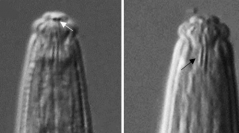

 European Journal of Taxonomy
925 (1) - Pages 1-45
European Journal of Taxonomy
925 (1) - Pages 1-45Five new and four known species of the genus Dorylaimellus Cobb, 1913 are described and illustrated from the Western Ghats of India. Dorylaimellus attenuatus sp. nov. has a 0.73–0.84 mm long body; lip region rounded, offset; odontostyle attenuated with indistinct lumen, odontophore 9–10 µm long; expanded part of pharynx 39–48% of neck length; female genital system amphidelphic and tail long filiform. Dorylaimellus cylindricaudatus sp. nov. has a 1.0–1.15 mm long body; lip region rounded, offset; odontostyle 4 µm long, odontophore 11–12 µm long; expanded part of pharynx 47–56% of neck length; female genital system amphidelphic, and tail elongate-cylindrical with rounded terminus. Dorylaimellus karnatakensis sp. nov. has a 1.2–1.3 mm long body; lip region rounded, offset; odontostyle 5 µm long, odontophore 12–13 µm long; expanded part of pharynx 45–53% of neck length; female genital system amphidelphic; spicules 22 µm long, ventromedian supplements four, and tail elongate-conoid dorsally convex. Dorylaimellus kasplateauensis sp. nov. has a 0.68–0.83 mm long body, lip region with a weak perioral disc; odontostyle 6–7 µm long, odontophore 11–14 µm long; expanded part of pharynx 38–43% of neck length; female genital system amphidelphic, and tail elongate arcuate conoid. Dorylaimellus tropicus sp. nov. has a 0.6–0.7 mm long body; lip region rounded, offset; odontostyle 4–5 µm long, odontophore 8–10 µm long; hemizonid present; expanded part of pharynx 43–52% of neck length; female genital system amphidelphic and tail elongate-filiform, sudden tapering, ending with rounded tip. Dorylaimellus andrassyi, D. discocephalus, D. belondirelloides, D. chakpilus are redescribed based on the specimens collected from several localities of the Western Ghats.
Belondiridae, biodiversity hotspot, description, nematode, taxonomy